Chemical Reactor Temperature Control System – LNEYA
The working principle, control mode, and detailed working conditions of the chemical reactor temperature control system can be customized. According to user requirements, the reasonable matching between low temperature and cooling capacity, low temperature and container capacity can meet the actual needs of different users. The main function of the temperature control system of the reactor is to dynamically control the temperature of the reactor, improve the heat transfer efficiency, meet the strict requirements of high process standards, close-cycle heating, small heat loss, and a wide range of applications.
Principle of chemical reactor temperature control system
In the chemical industry, the reactor is the key to the entire chemical process, and cooling has become a necessary condition for the reaction, which is related to the production quality of the entire finished product. The temperature control system of the reactor is selected by the cooling coil, which is equipped with cooling inlet and outlet, cooling water, refrigerant and external circulating coolant.
Regarding the orientation of the device for the cooling coil, the device is usually inside the reactor to reduce the temperature of the material in the reaction, and it can be placed outside when the material is highly viscous or the coil requires a mixed mode: in the case where the medium is used as a heat source for heating, the cooling The coil can be placed in the medium, and the heating of the resistance wire depends on the specific situation, but the heating effect and cooling effect should be considered.
The chemical reactor temperature control system adopts high-intelligence PLC and PC-level microcomputer control system, which can be operated remotely. It has timing switch and failure analysis, real-time recording and display of data, and drawing of curves. The data is automatically saved.
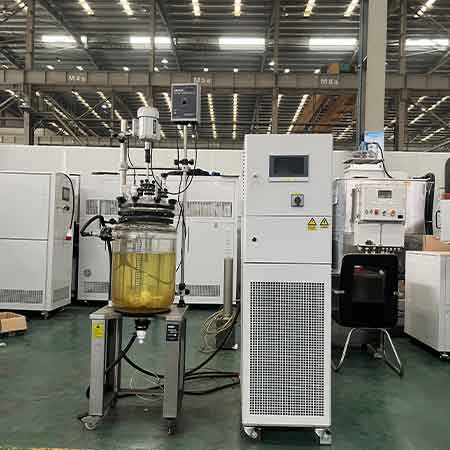
Control method of chemical reactor temperature control system
(1) Temperature control method: Temperature control methods can be divided into position control, proportional control, proportional integral control, proportional differential control, proportional integral differential control, computer intelligent control such as PLC, online non-contact temperature control, etc.
(2) Bit-type control: Bit-type control means that when the given temperature is higher than the set value, the heater is turned off, and when the lower limit temperature is lower than the set value, the heater is turned on. The temperature is always within a certain range, and the bit The control system is simple and reliable, and is generally used in conduction or convection heating occasions.
(3) Cascade control: Position control and proportional control When the load changes greatly, its temperature is difficult to maintain at the set value. To achieve this goal, we can add one or more sensors. When the temperature has not changed, the power can be adjusted in time to ensure the stability of the temperature.
(4) Online non-contact temperature control: This control method is mainly used in other occasions such as online detection and control of the process temperature of moving objects (such as online control of the working temperature of rolling objects and displacement objects).
Working condition selection of chemical reactor temperature control system
1. Select the circulation pump model according to the required coolant volume. Of course, the larger the capacity and the lower the temperature, the higher the price.
2. According to the different temperature required by the experiment, choose the cryopump with the corresponding temperature control range. The lower the temperature, the higher the price of the pump, and the low temperature of chemical reactor temperature control system can reach -120℃.
3. Whether the test solution is corrosive, if it is a strong acid or alkali solution, you need to purchase a corrosion-resistant reactor temperature control system.
Dynamische Temperaturkontrollsysteme (Unterstützung der Kundenanpassung)

Kühl- und Heizsysteme (Serie SUNDI) (Benutzerdefinierte Designs)
Temperaturregelbereich: -120°C bis +350°C
Anwendung: Verschiedene Reaktoren (Mikrokanäle, Glas, ummantelte Reaktoren usw.), Destillations- oder Extraktionssysteme, Labor, Universität, Forschungsinstitut, Luft- und Raumfahrt, Automobilindustrie, Halbleiter- und Elektrotests, Chemie, Pharmazie, Petrochemie, Biochemie, Medizin, Krankenhaus, F&E-Werkstatt, Luft- und Raumfahrt, Biologie und andere Industrien.
| Temperaturbereich | Serie -10 ~ +150°C | Serie -25 ~ +200°C | Serie -25 ~ +300°C | Serie -45 ~ +250°C | Serie -45 ~ +300°C | Serie -60 ~ +250°C | Serie -60 ~ +300°C | Serie -70 ~ +250°C | Serie -80 ~ +250°C | Serie -90 ~ +250°C | Serie -100 ~ +100°C | -25 ~ +200°C eine Maschine für zwei Reaktoren | -40 ~ +200°C eine Maschine für zwei Reaktoren |
| Kühlleistung | 1,5 ~ 15kW | 1 ~ 200kW | 1 ~ 200kW | 0,45 ~ 200kW | 0,9 ~ 25kW | 0,25 ~ 60kW | 0,75 ~ 25kW | 0,4 ~ 15kW | 0,3 ~ 80kW | 0,2 ~ 80kW | 0,45 ~ 80kW | bis zu 10*2kW | bis zu 10*2kW |
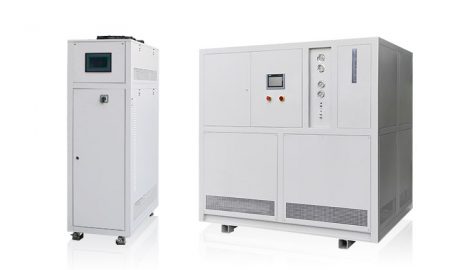
Kühl- und Heizsysteme (WTD-Serie) (Benutzerdefinierte Designs)
(Mikrokanal / Röhrenreaktoren spezialisiert)
Temperaturregelbereich: -70°C bis +300°C
Spezielles Design für Mikrokanäle (geringe Flüssigkeitsspeicherkapazität, starke Wärmeaustauschkapazität, Zirkulationssystem mit hohem Druckabfall)
| Temperaturbereich | -70°C ~ +300°C | -45°C ~ +250°C | -70°C ~ +200°C |
| Kühlleistung | 1.1 ~ 7.5kW | 1.5 ~ 5.5kW | 11 ~ 50kW |
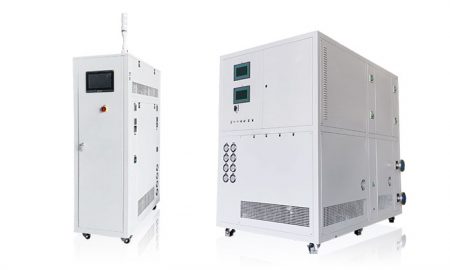
Kühl- und Heizsysteme (TES-Serie) (Benutzerdefinierte Designs)
Temperaturregelbereich: -85°C ~ +250°C
Temperaturregelungsgenauigkeit: ± 0,3°C
| Temperaturbereich | Serie -45°C ~ +250°C | Serie -85°C ~ +200°C | Serie -60°C ~ +200°C |
| Kühlleistung | 0,3 ~ 25kW | 0,25 ~ 25kW | 3 ~ 60kW |

Kühl- und Heizmaschinen (LTS-Serie) (Benutzerdefinierte Designs)
Temperaturregelbereich: -80°C bis +80°C
Es wird häufig in der Halbleiterindustrie eingesetzt, um die Temperatur der Reaktionskammer, der Heizplatte und des nicht brennbaren Wärmeträgers zu regeln.
| Temperaturbereich | -20°C ~ +80°C Reihe | Serie -45°C ~ +80°C | Serie -60°C ~ +80°C | Serie -80°C ~ +80°C |
| Durchflusskontrolle | 7 ~ 45 L/min | 7 ~ 45 L/min | 7 ~ 45 L/min | 7 ~ 45 L/min |

Umwälzpumpen für Kühlung und Heizung (Benutzerdefinierte Designs)
Temperaturregelbereich: -45°C bis +250°C
Anwendung: Verschiedene Reaktoren (Mikrokanäle, Glas, ummantelte Reaktoren usw.), Destillations- oder Extraktionssysteme, Labor, Universität, Forschungsinstitut, Luft- und Raumfahrt, Chemie, Pharmazie, Petrochemie, Biochemie, Medizin, Krankenhaus, F&E-Werkstatt, Luft- und Raumfahrt, Biologie und andere Industrien.
| Temperaturbereich | Serie -25°C ~ +200°C | Serie -45°C ~ +250°C |
| Kühlleistung | 1 ~ 15kW | 0,25 ~ 15kW |
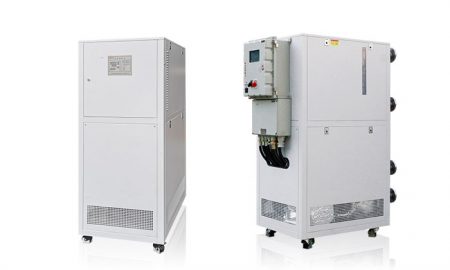
Heizungsumwälzpumpen (Benutzerdefinierte Designs)
Temperaturregelbereich: +50°C bis +300°C
Hinweis: Die UC-Serie kann die Temperatur des Wärmeträgermediums regeln. Die UST-Serie kann nicht nur die Temperatur des Wärmeträgermediums, sondern auch die Temperatur des Reaktionsmaterials regeln.
| Temperaturbereich | +50°C ~ +170°C (UC-Serie) | +50°C ~ +300°C (UC-Serie) | +50°C ~ +300°C (UST-Serie) |
| Heizleistung | 5,5 ~ 15kW | 3,5 ~ 130kW | 3,5 ~ 95kW |
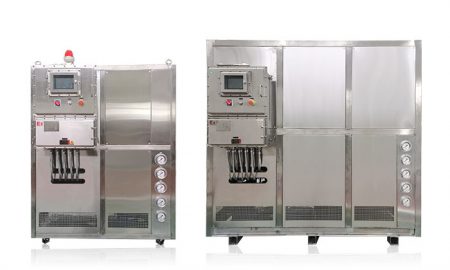
TCU Multireaktoren Temperaturkontrollsystem (Benutzerdefinierte Designs)
Temperaturregelbereich: -120°C bis +250°C
Anwendung: Verschiedene Reaktoren (Mikrokanäle, Glas, ummantelte Reaktoren usw.), Destillations- oder Extraktionssysteme, Labor, Universität, Forschungsinstitut, Luft- und Raumfahrt, Chemie, Pharmazie, Petrochemie, Biochemie, Medizin, Krankenhaus, F&E-Werkstatt, Luft- und Raumfahrt, Biologie und andere Industrien.
| Temperaturbereich | Serie -45°C ~ +250°C | -120°C ~ +250°C Reihe | Kundenspezifisches Temperaturkontrollsystem | RT+10°C ~ +135°C |
| Heizleistung | 25 ~ 80kW | 25 ~ 80kW | Benutzerdefiniert | 25 ~ 300kW |
 LNEYA
LNEYA
 简体中文
简体中文


















































































